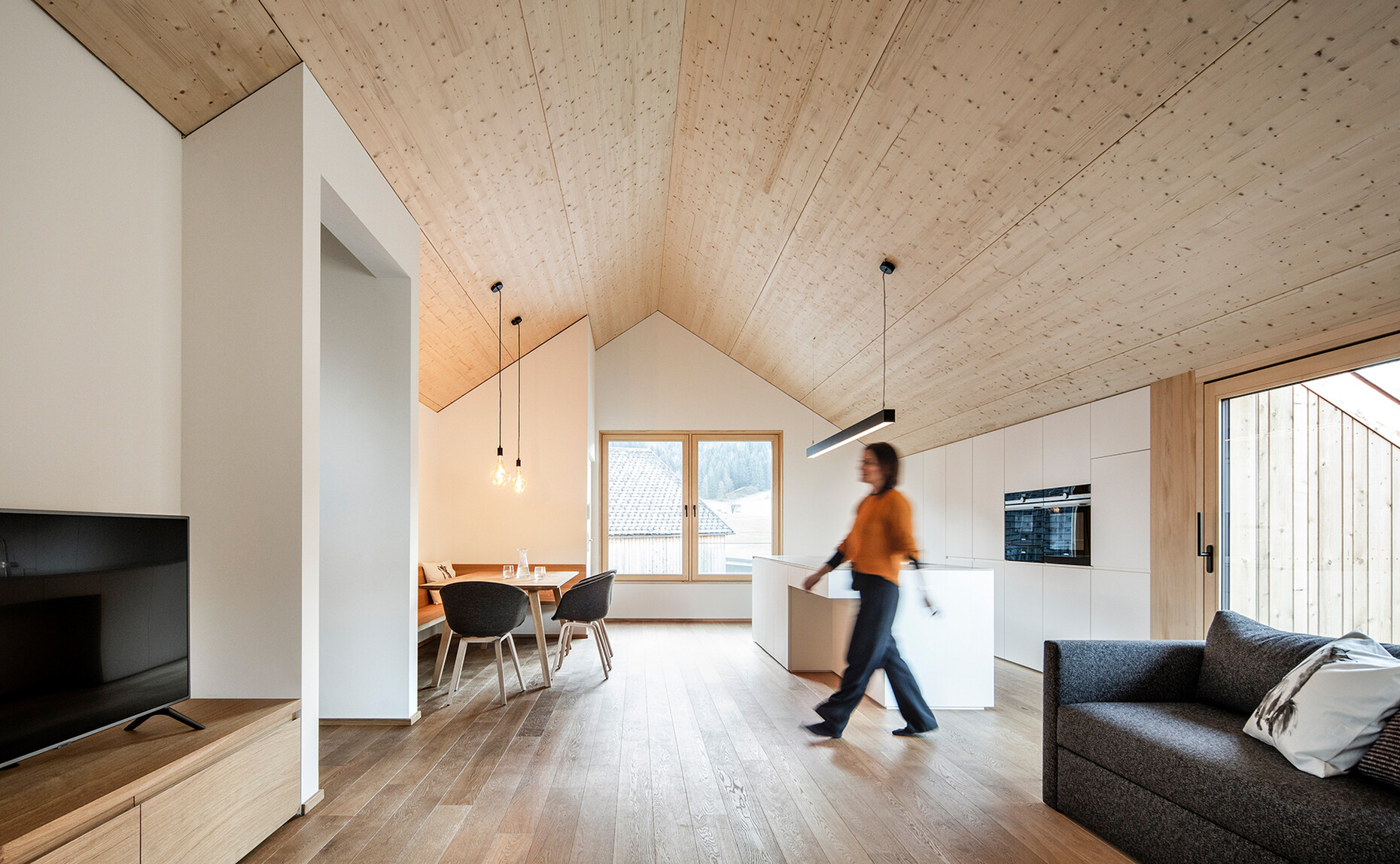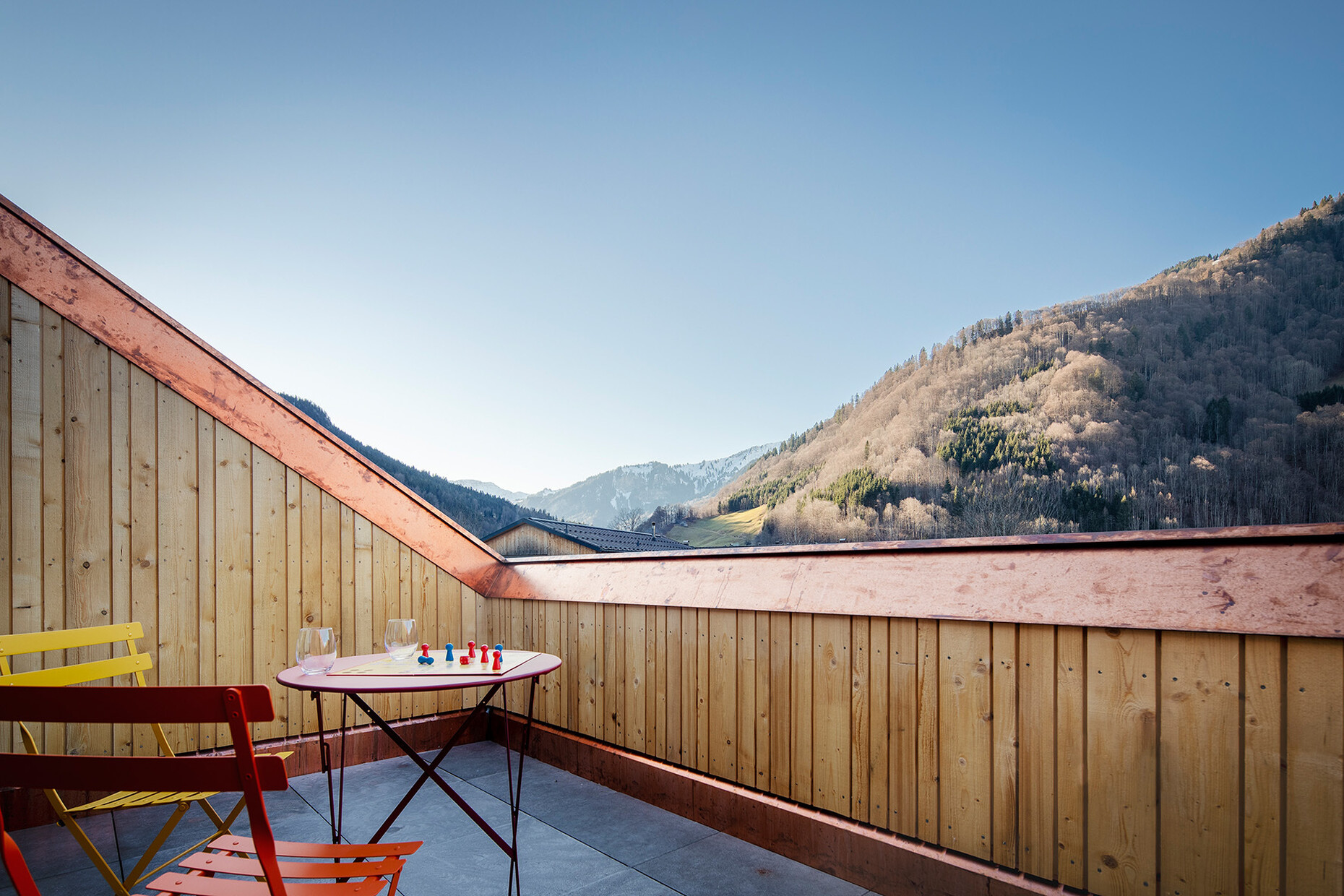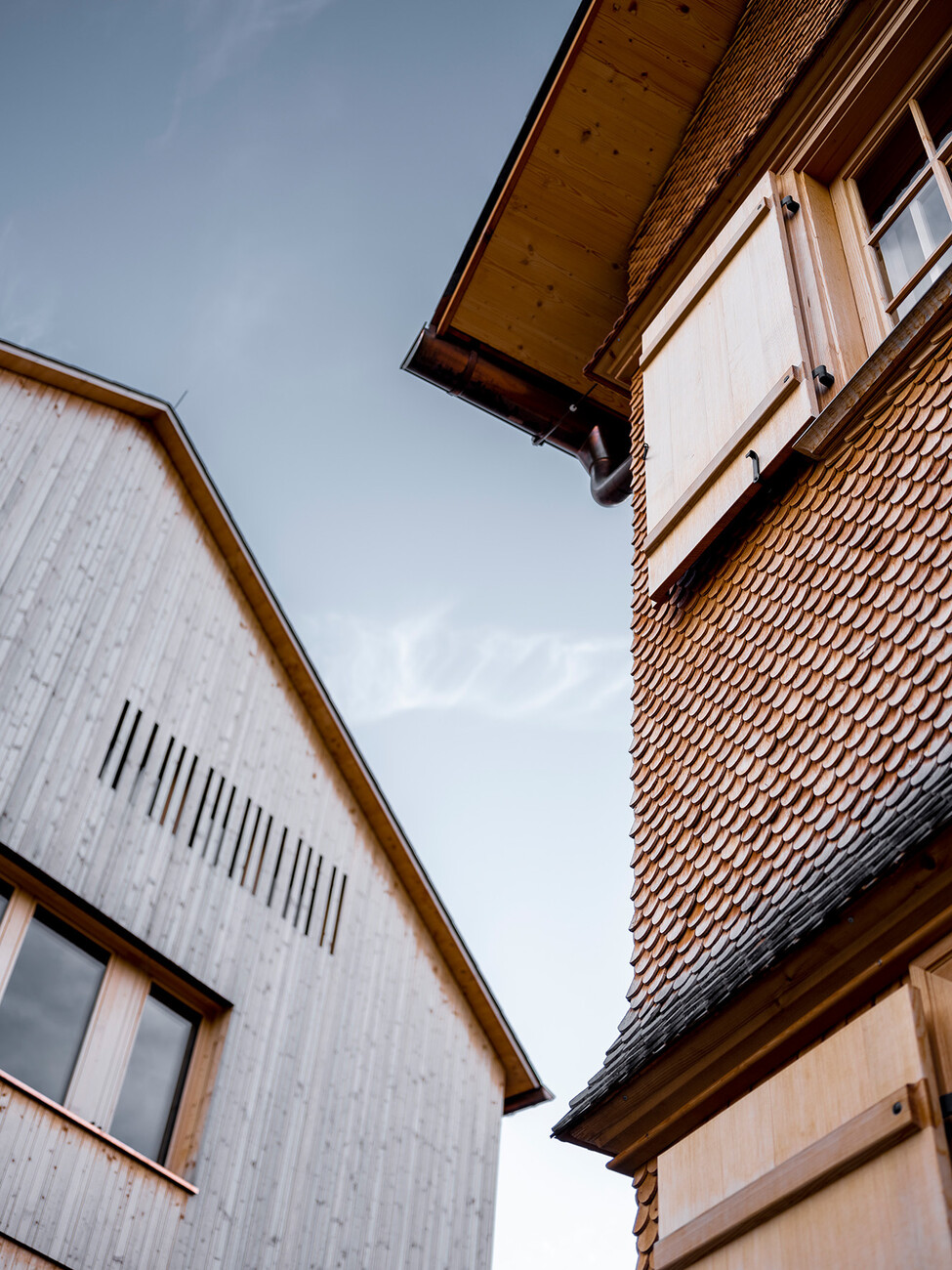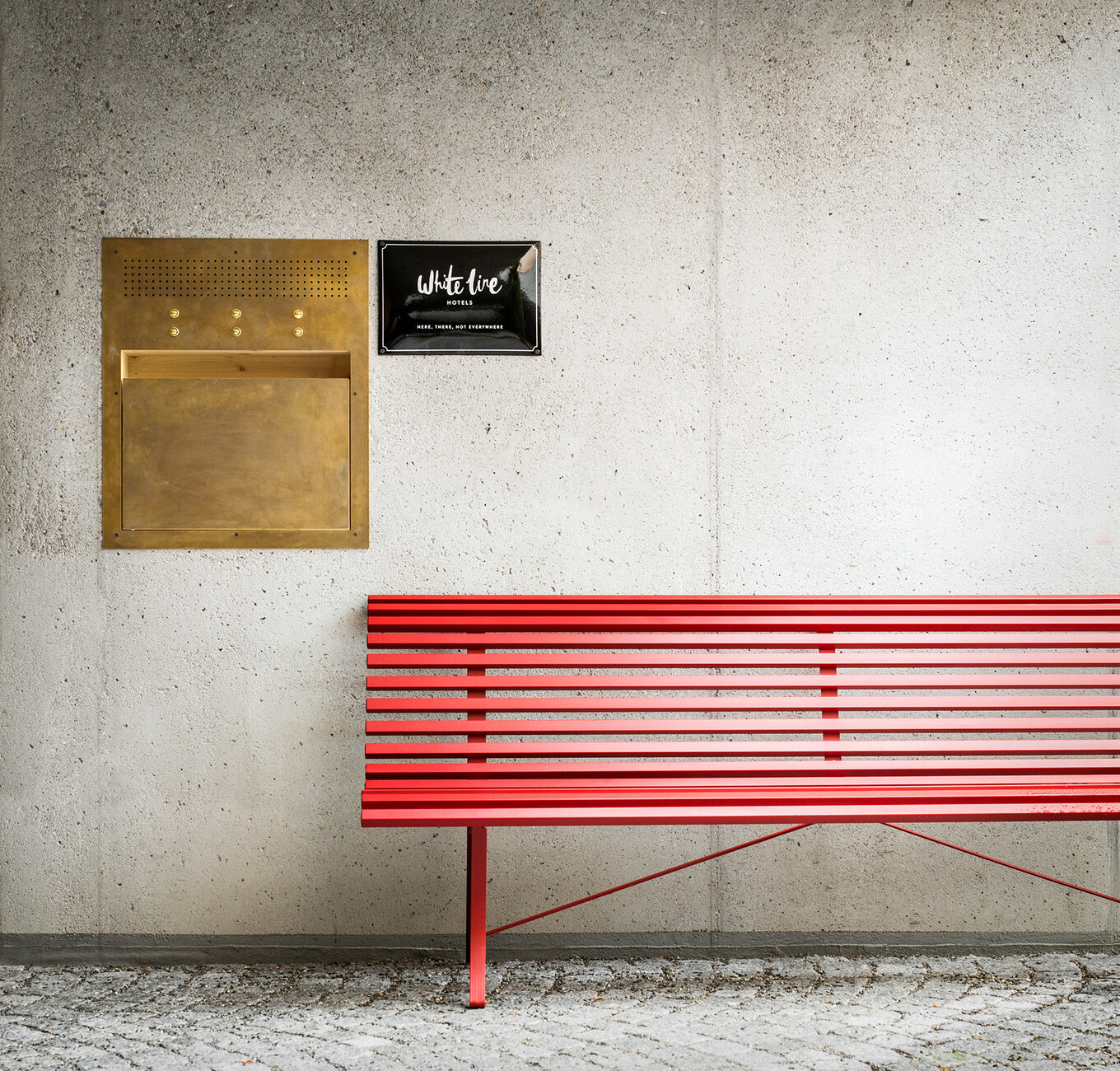HOTEL
Living craftsmanship
The Mesmerhaus in Bildstein shows what can happen when traditional craftsmanship, modern living comfort and attention to detail come together in the right place at the right time. With a view of Lake Constance, hostess Evi and her husband Jürgen Haller - an architect by profession - have created a new form of holiday architecture in the Austrian province of Vorarlberg and developed the prototype for their Temple 74, so to speak. Two structures, simple, reduced, natural and open in their appearance, create a kind of village square for the Tempel district in Mellau with the connecting "good parlour". Guests are cordially invited to come together informally. There is no need for a proper restaurant, but the well-equipped Honesty Bar is absolutely in tune with the times: no compulsion to consume, but an offer to enjoy regional products on site or at home. Those who want to enjoy the last rays of sunshine outside after a long day or stretch their legs in front of the blazing fire often don't stay alone for long. Hostess Evi Haller may be baking waffles in the kitchen or her husband Jürgen may drop by for a visit. It is not without reason that his architectural office is located in one of the apartment buildings: "Our guests should and may share our life as hosts with us to a certain extent. We like to exchange ideas, give personal tips or tell interested people about Bregenzerwald architecture."
This approach is immediately noticeable during a visit to Temple 74: the flats are all spacious, bright, natural and simply cosy in design. Under the motto "less is more", the focus here is on the material wood, both inside and out. The architecture is kept open, magically attracts glances and accordingly opens up numerous different perspectives on the surrounding natural landscape from within. Modern at first glance, the ensemble nevertheless blends seamlessly into the evolved village structure and is a successful example of what architecture and craftsmanship are capable of when passion and know-how meet. In the interview, architect and master builder Jürgen Haller talks about building culture and plans for the future.
Linda Pezzei: Your office is located in the apartment building Tempel 74, which you designed and manage - what exactly do you understand by quality building culture in this sense?
Jürgen Haller: Craft and tradition determine the identity of a building. Clear in their design language and rooted in tradition, this is how we fill our wooden buildings with a soul. Forest and wood run through all areas. The sensual quality of the mostly untreated regional building materials gives the building a homely atmosphere and a unique living experience.
Temple 74 is mainly aimed at people interested in culture and architecture who want to spend some time here and be inspired - what can your guests expect?
Jürgen Haller: My wife Evi represents the passion of hospitality, I represent the connection between architecture and craftsmanship. Together we stand for living culture at its best in Tempel 74. Those who spend their holidays here experience both of us – authentically and personally. I grew up in Mellau. A connoisseur of the village and the impressive Bregenzerwald building culture. I took the opportunity to build a flat house in this unique location in cooperation with Bregenzerwald craftsmen, which also houses my architectural office. The goal was to develop a project that corresponds to our idea of living culture in every detail. The sensual, spatial and functional qualities make a stay in Tempel 74 something special. The focal point of the Tempel hamlet is the communal running well, which was already a meeting point and place of encounter in days gone by as a washing place and cattle watering place. The new building is also based on this by complementing the existing ensemble in scale, material and form. Everything that makes everyday life in the Bregenzerwald so cosy and high-quality was the model and incentive for our flat house in Mellau – especially the Stube as a successful contribution of the Alps to living culture. For my wife Evi, the focus is not only on aesthetics, but above all on the personal. From the first enquiry until departure, she takes care of the guests' wishes, among other things with personal tips on cultural offerings and the surrounding nature. Evi's homemade cakes and the extensive breakfast, which is placed in front of the flat door every morning, are already real classics.
To what extent is Temple 74 a showpiece when it comes to combining architecture and craftsmanship?
Jürgen Haller: Architecturally speaking, the temple in Mellau is the Bregenzerwald in miniature and has all the advantages of the building culture of the Bregenzerwald. House A is the detailed reconstruction of a building with a craftsman-rural tradition. Typical features are, for example, the box and diamond windows and the round shingles. House B is a new building that continues the regional building tradition in a free interpretation. It is clad with a transparent wooden curtain that plays with open and closed façade surfaces. On the outside and inside, local wood species such as spruce and oak are used, as well as sanded screed with sand aggregate from the Bregenzerach river as flooring. The two houses are connected in the basement via the underground garage and on the entrance floor via a large parlour that invites you to linger and relax. Corner bench, credenza and seating in the tradition of the canapé as well as the stove as a central fireplace stand for the typical Bregenzerwald cosiness and offer guests a place of well-being. Only craftsmen and businesses from the region were commissioned.
Vorarlberg architecture is strongly characterised by the region, the building material wood and its craftsmanship, as well as its own understanding of living culture – how can this be communicated to your guests (also beyond the borders)?
Jürgen Haller: Vorarlberg builds differently. Architects and craftsmen design surprisingly modern things. Works of simple elegance, with special sensual qualities. Today's building style is based on traditional knowledge and skills that are constantly being developed. Hardly any other region in the world has such a density of high-quality timber architecture and harmoniously combines old and new building culture. The demand for energy efficiency and sustainability is just as high as the demand for design. Vorarlberg's exceptional timber architecture is now known far beyond its borders and makes the region a popular holiday destination for guests interested in architecture and culture.
You deliberately decided against the city and in favour of the "province" with your office location – why?
Jürgen Haller: If you want to be successful as an entrepreneur, sooner or later you will ask yourself whether it would be better to move from the province to the city. For us, this question does not arise. Our home in Bregenzerwald is the right place for our approach to architecture. But we have deliberately located our office in an apartment building – in Tempel 74 in Mellau. Because there, where the world is our guest, we find impulses from outside that challenge and inspire us.
What special challenges can you face as an architect in the Bregenzerwald and what unique opportunities can arise?
Jürgen Haller: Since Vorarlberg, and especially the Bregenzerwald, is a paradise for architecture and culture enthusiasts, encounters often arise from which beautiful projects sometimes develop abroad. Sometimes such encounters also lead to close friendships and long-standing connections.
Every Friday you give a guided tour of Mellau and talk about Bregenzerwald architecture - why is this particularly important to you and who are your listeners?
Jürgen Haller: As a passionate master builder, I live the successful combination of architecture and craftsmanship. The office is always open for our guests of Tempel 74 and the Mesmerhaus. During my weekly guided tours to the architectural highlights in Mellau and the surrounding area, I share my detailed experiences from the idea to the realisation of a building. Shop talk and personal exchange in a holiday mood - what could be better?
A project that you would definitely like to realise in the region and why?
Jürgen Haller: As our two children reach adolescent age, I am worried about where and how they can spend their free time and, above all, their night times. In our youth there were still some nightclubs, discos and meeting places for the young. With the death of pubs, these places have also disappeared. In the meantime, there are also ambitions to accommodate such premises in semi-public projects. Unfortunately, this is all going very slowly and mostly fails because of the costs and the political decision-makers. A house for the youth with a disco, localities etc. would be a nice challenge.
Tips from Jürgen Haller – Visit to the Bregenz Forest
Must-do: BUS:STOP Krumbach. Architects from seven different countries designed seven different bus stops in Krumbach, small utility buildings in public space. But that is only one side of a courageous project. On the other side is an unusual dialogue with Vorarlberg tradition, building culture and craftsmanship.
Must-try: s`Ernele Hittisau. The shop is a showcase for the region - in more ways than one: chef Felix Groß, a good friend of ours, prepares the dishes directly in the dining room. Only products from a maximum of 100 kilometres away and from the large in-house vegetable and herb garden make it onto the plates. The well-stocked shelves offer selected gems with Bregenzerwald roots. And the design language of the modern, light-flooded wooden cube is unique in Vorarlberg. The closeness to the guest, the uncompromising relationship with the products and suppliers and the extraordinary architecture and atmosphere make the Ernele incomparable.
Must-see: Werkraum Andelsbuch. Inspiring each other, tackling, learning and growing - anyone who approaches the Werkraum Haus recognises the community spirit that precedes this building. Pioneer and architect Peter Zumthor got to know the craftsmen from the Bregenzerwald in the mid-1990s during the construction of the Kunsthaus Bregenz. Together with them, he realised the visionary, powerful design of the Werkraum-Haus from 2008 to 2013.
Contact
Tempel 74
6881 Mellau, Austria
Phone: +43 5518 21076




























